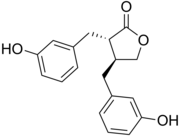肠内酯
化合物
肠内酯(英语:Enterolactone)是一种有机化合物,属于一种肠木脂素,化学式为C18H18O4。它是由肠道细菌分解食物中存在的植物木脂素产生。
| 肠内酯 | |
|---|---|

| |
| IUPAC名 (3R,4R)-3,4-Bis[(4-hydroxyphenyl)methyl]oxolan-2-one | |
| 别名 | (−)-肠内酯 |
| 识别 | |
| 缩写 | ENL |
| CAS号 | 78473-71-9 |
| PubChem | 10685477 |
| SMILES |
|
| KEGG | C18165 |
| 性质 | |
| 化学式 | C18H18O4 |
| 摩尔质量 | 298.33 g·mol−1 |
| 外观 | 白色固体[1] |
| 若非注明,所有数据均出自标准状态(25 ℃,100 kPa)下。 | |
来源
编辑许多膳食植物木脂素前体,如开环异落叶松脂素、罗汉松脂酚、落叶松脂素和芝麻素等可以被肠道菌群代谢产生肠内酯[2][3][4]。在食用植物中,木脂素常与纤维结合,因此富含纤维的食品,如谷物、蔬菜、水果和浆果,通常是木脂素和肠内酯的良好来源。已知最丰富的肠内酯前体膳食来源是亚麻籽和芝麻籽[5][6][7]。肠内酯由特定肠道菌群产生,因此不同的人之间产生肠内酯能力不同[8]。使用抗生素对使肠内酯生产能力下降,而且需要一年才能恢复[9][10]。
健康效益
编辑肠内酯被认为对人类具有有益的健康作用。流行病学研究表明,乳腺癌患者的肠内酯浓度低于健康人群,这可能表明肠内酯具有抗癌作用。肠内酯和一些木脂素也可能对心血管疾病有预防作用[11][12]。
参考文献
编辑- ^ Svitlana Shinkaruk; et al. Design and validation of a novel immunological test for enterolactone. Talanta. 2014. 119. 116-124. doi:10.1016/j.talanta.2013.10.034. Supp. Mat.
- ^ Lampe JW. Isoflavonoid and lignan phytoestrogens as dietary biomarkers. J Nutr. 2003, 133 (Suppl 3): 956S–964S. PMID 12612182. doi:10.1093/jn/133.3.956S .
- ^ Peñalvo JL, Heinonen SM, Aura AM, Adlercreutz H. Dietary sesamin is converted to enterolactone in humans. J. Nutr. May 2005, 135 (5): 1056–1062. PMID 15867281. doi:10.1093/jn/135.5.1056 .
- ^ Heinonen, S; Nurmi, T; Liukkonen, K; Poutanen, K; Wähälä, K; Deyama, T; Nishibe, S; Adlercreutz, H. In vitro metabolism of plant lignans: New precursors of mammalian lignans enterolactone and enterodiol. Journal of Agricultural and Food Chemistry. 2001, 49 (7): 3178–86. PMID 11453749. doi:10.1021/jf010038a.
- ^ Milder, I. E.; Arts, I. C.; Van De Putte, B; Venema, D. P.; Hollman, P. C. Lignan contents of Dutch plant foods: A database including lariciresinol, pinoresinol, secoisolariciresinol and matairesinol. The British Journal of Nutrition. 2005, 93 (3): 393–402. PMID 15877880. doi:10.1079/bjn20051371 .
- ^ Thompson, L. U.; Boucher, B. A.; Liu, Z; Cotterchio, M; Kreiger, N. Phytoestrogen content of foods consumed in Canada, including isoflavones, lignans, and coumestan. Nutrition and Cancer. 2006, 54 (2): 184–201. PMID 16898863. S2CID 60328. doi:10.1207/s15327914nc5402_5.
- ^ Smeds, A. I.; Eklund, P. C.; Sjöholm, R. E.; Willför, S. M.; Nishibe, S; Deyama, T; Holmbom, B. R. Quantification of a broad spectrum of lignans in cereals, oilseeds, and nuts. Journal of Agricultural and Food Chemistry. 2007, 55 (4): 1337–46. PMID 17261017. doi:10.1021/jf0629134.
- ^ Clavel, T; Doré, J; Blaut, M. Bioavailability of lignans in human subjects. Nutrition Research Reviews. 2006, 19 (2): 187–96. PMID 19079885. doi:10.1017/S0954422407249704 .
- ^ Setchell, K. D.; Lawson, A. M.; Borriello, S. P.; Harkness, R; Gordon, H; Morgan, D. M.; Kirk, D. N.; Adlercreatz, H; Anderson, L. C.; Axelson, M. Lignan formation in man--microbial involvement and possible roles in relation to cancer. Lancet. 1981, 2 (8236): 4–7. PMID 6113409. S2CID 39049097. doi:10.1016/s0140-6736(81)90250-6.
- ^ Kilkkinen, A; Pietinen, P; Klaukka, T; Virtamo, J; Korhonen, P; Adlercreutz, H. Use of oral antimicrobials decreases serum enterolactone concentration. American Journal of Epidemiology. 2002, 155 (5): 472–7. PMID 11867359. doi:10.1093/aje/155.5.472 .
- ^ Adlercreutz, H. Lignans and human health. Critical Reviews in Clinical Laboratory Sciences. 2007, 44 (5–6): 483–525. PMID 17943494. S2CID 31753060. doi:10.1080/10408360701612942.
- ^ Peterson, J; Dwyer, J; Adlercreutz, H; Scalbert, A; Jacques, P; McCullough, M. L. Dietary lignans: Physiology and potential for cardiovascular disease risk reduction. Nutrition Reviews. 2010, 68 (10): 571–603. PMC 2951311 . PMID 20883417. doi:10.1111/j.1753-4887.2010.00319.x.